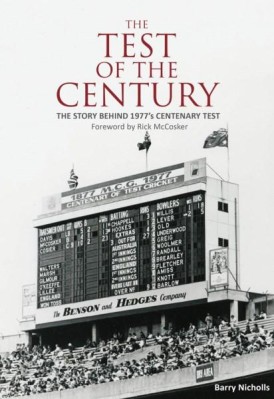The Test of the Century
Martin Chandler |Published: 2016
Pages: 252
Author: Nicholls, Barry
Publisher: New Holland
Rating: 3.5 stars

There haven’t been too many examples of individual cricket matches inspiring a full length book on their own. The first tied Test, between Richie Benaud’s Australia and Frank Worrell’s West Indians in 1960/61 was certainly one, but there are only a few others. A handful of Tests between Australia and England have done so as well and, almost forty years after the game was played, Barry Nicholls has now contributed an account of the 1977 Centenary Test.
Being of a certain age I remember the Centenary Test very well. In those days it was quite often necessary to resort to radio commentary, and with the BBC not seeking to televise the match live I certainly lost plenty of sleep listening to Test Match Special through the night.
England arrived in Australia in March after a successful, but no doubt exhausting trip to India. There wasn’t a great deal of genuine optimism before the showpiece started, but after England shot the Aussies out for a mere 138 before ending up on 29-1 at the end of the first day that all changed.
So far so good was the view in the northern hemisphere, but our dreams of avenging the indignities inflicted by Dennis Lillee and Jeff Thomson in 1974/75 were dealt a hammer blow on the second day when Lillee and Max Walker shot England out for 95. No one expected the Aussies to collapse again and they didn’t. There was a wobble early on in their second innings, but then Ian Davis and Doug Walters started a recovery that a young David Hookes added to by famously flaying the bowling of England skipper Tony Greig.
After Hookes was dismissed Rod Marsh then went to a century as he skilfully marshalled the tail, including opening batsman Rick McCosker who went in at number ten after having had his jaw broken in the first innings by Bob Willis. Photographs of McCosker at the crease with his face swathed in bandages are one of the enduring images of the match.
England’s target was a distant 463 in all but two days. After the first innings debacle no one expected them to get within a lion’s roar. The inevitable defeat did follow, but the margin of defeat was not the expected three hundred or so and in a remarkable piece of historical symmetry it ended up as 45 runs, exactly the same margin as in the match being celebrated. It was Derek Randall’s finest hour. He scored a superb 174 and whilst he was at the crease there was real hope and, briefly, almost expectation.
However exciting a cricket match is, and irrespective of the quality of the individual performances, to take 252 pages to describe the play would lead to a turgid read. Fortunately Barry Nicholls is an experienced writer and the story of the match, skilfully told, takes up no more than fifty pages.
There are 136 pages before the match begins. Nicholls uses those to set out a short but necessary account of ancient history, some biographical details of the participants and a great deal of context. The Australians took their responsibilities in producing the celebration extremely seriously, and they made a splendid job of it. The book concludes neatly with a brief look at the post match celebrations, followed by a glimpse at the momentous events of 1977. As an Aussie it was no surprise that before winding up with a review of what became of the members of the 1977 teams Nicholls makes a brief mention of the 1980 Centenary Test in England. The chapter on that game takes up all of six pages, which is about the number it deserved. Having been given an object lesson in how to stage a celebration of Test cricket England’s players and administrators seemed to have learnt little from their Australian counterparts.
More than 200 former players were invited to join in the celebrations. One of them was Bill Voce, reunited with his old opening partner Harold Larwood who had been living in Australia for many years. For this reviewer Nicholls might have made more of the nostalgia, although I have no doubt that subject could have filled a book on its own. To give just one example Larwood’s account of his emotions when he walked out with Voce before the packed MCG in one of the intervals brings a lump to the throat. I assume television cameras captured that part of the celbration, although sadly I have no recollection of ever seeing the footage. It must have been quite a moment when Voce, not normally noted for his sense of humour, made as if to mark out his run.
All in all however I think I have to concede that Nicholls gets the mix of his ingredients just about right, and The Test of the Century is an evocative and engrossing read. There has been a good deal of input from those involved. In that there is an element of bias, Gary Cosier, Ian Davis and Rick McCosker being quoted at much greater length than any of the England players, but I suppose that is an inevitable consequence of Nicholls’ being based in Australia. There is one disappointment, that being the lack of any illustrations in the book. There were so many iconic moments in the centenary Test that even a basic collection of the better known photographs would have enhanced the experience.







Leave a comment